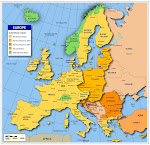By Claire
We woke at dawn, literally. We were informed that our guide would be arriving at 7 am to take us to the Temple of Horus at our first stop of the day in Edfu. I couldn’t believe how gorgeous the sunrise was, coming up through the palm trees along the Nile

Our very friendly guide, Ahmed, arrive early and escorted us to a Calèche, an old-fashioned horse drawn carriage—telling us that it would cost 20 LE (€2.60) and that we would not pay until we were returned to our boat. We picked up another couple from a different boat—ah the joy of speaking English! They were from Israel and we were disappointed that they weren’t on our boat.
Calèche chaos—I love this guy with the cell phone; he seemed to be in charge


It was kind of nice riding in the carriage but I didn’t like the way the drivers whipped the horses and I noticed that some of their hooves slipped on the street. It seems a terrible life for a horse.
The Temple was impressive and is considered the best preserved in Egypt. Ahmed was enthusiastic, friendly and thankfully repeated the information again and again which really helped our understanding.
Temple of Horus


Many of the carvings of the gods were destroyed by the Christians using a chisel. They considered them evil.

Ahmed was really great about getting us around the ever increasing crowds and into areas with no one around.
Ahmed

When he was finished, he gave us 15 minutes to wander around on our own. It was packed with people by now and became a pushing and shoving match just to get out of the place. I really dislike crowd mentality. Once again, we were very grateful to have our own guide—I’m not sure how we could have heard a guide in a group situation.
The rest of the afternoon was spent doing the usual: reading, relaxing, taking in the varying sights along the Nile and indulging at “Tea Time.”
Dahabiyya

At Gebel Silsilla, 42 km south of Edfu—one of the narrowest points on the Nile—we floated past shrines and chapels left by Pharaohs of different periods. The most impressive of these is the rock-cut chapel of Speos of Horemheb (1323-1295 BC).
Rock-cut chapel




We docked in Kom Ombo, a small village located 40 km. north of Aswan. We were told our guide would arrive at 5 to pick us up. I still can’t get over the fact that our trip included a private guide for every sight. The rest of the people on the boat leave in a herd. We have enjoyed every one of our guides and this evening’s was no different—Mahmoud was friendly and helpful. We were able to walk to the Temple of Haroeris (Horus) and Sobek and it was balmy out, a nice change from the cool weather we had in Lower Egypt. He showed us an Egyptian calendar—very interesting—it was divided up into 3 seasons of 4 months each with 3 weeks for each month and 10 days per week. This accounts for 360 days. The missing days were festival days for 5 of their important gods. If you add it all up you get 365 days. Mahmoud tried to help me get a picture of the calendar and told me to just push my way to the front of a large tour group but that’s just not my style. So, he started yelling at the guide, insisting that I should be able to go to the front and get a picture. We’ve experienced this before but again, not my style. He seemed to want me to get that picture so he offered to do it. The picture didn’t turn out—no big surprise.
I was fascinated by these two carvings, one of a woman giving birth and the other of the mother breastfeeding. I’m embarrassed to admit that when Mahmoud asked me what I thought it was a picture of, all I could see was a woman sitting on a desk chair.
Birth

Breast feeding

Next came the Nilometer. It gave advance notice as to whether there would be regular, excessive or minimal flooding and thus whether there would be abundant, none or minimal crops (and starvation).
Nilometer

Inside the temple was a hospital; but only for the rich. In fact, the common people were only allowed into the outer courtyard. We were able to glance inside some of the clinics, which were richly carved, but the government has closed them because too many people were using these rooms to have sex, according to Mahmoud. From there we got into an interesting conversation about politics in the U.S. and in Egypt. Mahmoud knew all about Arnold Schwarzenegger and told us that the people of Egypt love Obama. We have heard this several times since we’ve been here.
For those who wish to be wise, to be healthful, to borrow one month of real pleasure from a serious life, I would say, come and see the Nile. ~ H. M. Stanley, My Early Travels and Adventure (1895)


No comments:
Post a Comment